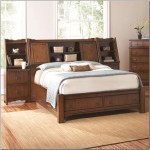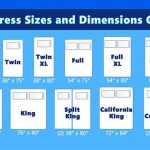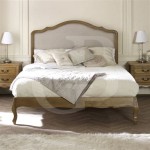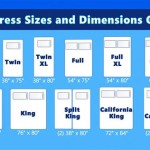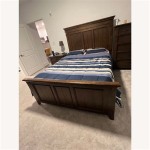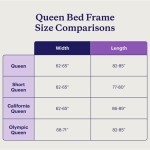Size of Quilts for Beds
Choosing the right quilt size can significantly impact sleep quality and bedroom aesthetics. A quilt that is too small can leave parts of the bed exposed, leading to drafts and discomfort. Conversely, an excessively large quilt can be cumbersome and difficult to manage, bunching up on the floor and creating a cluttered appearance. Understanding standard quilt dimensions and how they relate to bed sizes is crucial for making an informed purchase.
Standard Quilt Sizes and Their Corresponding Bed Sizes
Quilt sizes are typically categorized based on standard bed dimensions. While some variation exists between manufacturers, the following measurements generally apply:
- Twin/Single: Twin quilts are designed for standard twin beds (approximately 39 inches wide by 75 inches long). A typical twin quilt measures around 66 inches wide by 90 inches long, providing adequate coverage for a single sleeper.
- Twin XL: Twin XL beds are longer than standard twin beds, measuring around 39 inches wide by 80 inches long. A twin XL quilt usually measures approximately 66 inches wide by 96 inches long to accommodate the extra length.
- Full/Double: Full or double beds measure roughly 54 inches wide by 75 inches long. A full/double quilt typically measures 81 inches wide by 90 inches long, offering ample coverage for one or two sleepers.
- Queen: Queen beds are a popular choice, measuring about 60 inches wide by 80 inches long. Queen quilts are typically 90 inches wide by 90 inches long (or sometimes 92 by 96 inches) to provide sufficient coverage and overhang.
- King: Standard king beds, also known as Eastern King, measure around 76 inches wide by 80 inches long. King-size quilts usually measure 104 inches wide by 90 inches long, offering a generous amount of fabric for comfortable coverage.
- California King: California King beds are longer and narrower than standard king beds, measuring approximately 72 inches wide by 84 inches long. California King quilts measure around 104 inches wide by 96 inches long to accommodate the increased length.
Factors to Consider Beyond Bed Size
While bed size is the primary factor in choosing a quilt, other considerations can influence the ideal size. Personal preference plays a role; some individuals prefer a minimal drop, while others prefer a more substantial overhang. The thickness of the mattress should also be taken into account, as thicker mattresses require larger quilts to achieve the desired drop. Additionally, the height of the bed frame can affect the perceived drop length. For those sharing the bed with a partner or pets, a larger size might be preferred to ensure adequate coverage for everyone.
Measuring for the Perfect Fit
To determine the ideal quilt size, measure the bed's width, length, and height. Consider the desired drop length – the distance the quilt hangs over the sides and foot of the bed. A common drop length is 15-20 inches on each side and the foot of the bed. Add the desired drop to the bed's width and length to calculate the minimum quilt dimensions. For example, for a queen bed (60 inches wide by 80 inches long) with a desired 20-inch drop, the minimum quilt width would be 100 inches (60 + 20 + 20) and the minimum length would be 120 inches (80 + 20 + 20). This calculation helps ensure the quilt provides adequate coverage and the desired aesthetic.
Alternative Quilt Sizes and Uses
Beyond the standard sizes, some manufacturers offer alternative dimensions or specialized quilt types. Oversized quilts, for instance, provide an even more generous drop and coverage. Throw quilts are smaller and lighter, ideal for adding warmth and style without the bulk of a full quilt. They can be used on beds, sofas, or chairs. Baby quilts are designed specifically for cribs and bassinets, offering a smaller, safer size for infants and toddlers. Understanding these variations expands the options for utilizing quilts throughout the home.
Material and Construction Considerations
While size is paramount, the material and construction of the quilt should also be evaluated. Natural fibers like cotton and linen offer breathability and comfort, while synthetic materials like polyester provide durability and easy care. The quilt's fill weight influences its warmth and overall feel; lighter fills are suitable for warmer climates, while heavier fills provide greater insulation for colder environments. The stitching pattern impacts the quilt's durability and aesthetic, with options ranging from simple straight lines to intricate quilting designs. Considering these factors ensures a quilt that not only fits the bed appropriately but also meets individual needs and preferences for comfort and style.

Quilt Size Guide For Bed Quilts New Quilters

Standard Quilt Sizes Finding The Right Size Local Furniture Outlet

Standard Quilt Sizes Quit Guessing Will This Fit My Bed

Quilt Size Guide For Bed Quilts New Quilters

Quilt Sizes The Most Popular Standard Dimensions To Make Your Quilts Sewguide

Single Size Quilts Duvets Bed Bath N Table

Single Size Quilts Duvets Bed Bath N Table

Standard Quilt Sizes Finding The Right Size Local Furniture Outlet

Making Bed Size Quilts The Little Mushroom Cap A Quilting Blog

Bed Size Quilts Favequilts Com

